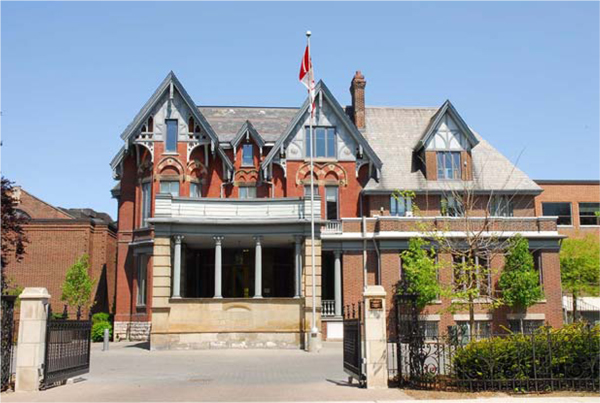Featured Project : Branksome Hall – Porte Cochere Review 10 Elm Avenue, Toronto, Ontario
 We were requested to carry out construction review the Porte Cochere repairs in conjunction with a repair scope of work prepared by Everest Restoration for Branksome Hall. In preparation for this work, an application to Heritage Preservation Services has been assembled by The Finlayson Practice, with contract drawings of the proposed work. Egberts Engineering Limited carried out a condition survey of the Porte Cochere on April 21, 2014 and our observations and recommendations follow.
We were requested to carry out construction review the Porte Cochere repairs in conjunction with a repair scope of work prepared by Everest Restoration for Branksome Hall. In preparation for this work, an application to Heritage Preservation Services has been assembled by The Finlayson Practice, with contract drawings of the proposed work. Egberts Engineering Limited carried out a condition survey of the Porte Cochere on April 21, 2014 and our observations and recommendations follow.
Description of proposed work / Repair area: The existing front entry of 10 Elm Avenue is a covered Porte Cochere, located on the south side of the building, which is at the north east corner of Mount Pleasant Road and Elm Avenue. It is constructed of ashlar stone walls, stone piers and steps, with fluted wood columns and a presumed wood roof above (see photo 1 attached). The roof has a decorative parapet railing, which is intended as a visual decorative feature and not a guard around the roof. Roofing is a conventional felt, gravel and asphalt built up roof. Existing and historic photos were provided for reference, together with drawings by The Finlayson Practice and these have been used in establishing recommendations for repairs that follow below.
Observations:
- The wood parapet does not conform with historic photos provided and it is concluded that the parapet has been removed and replaced sometime in the past (Refer to supplied photos No. 1, 2 and 3 )
- The wood rails in the parapet are rotten and have effectively broken across the width in some locations. They are not repairable and are at the end of their useful life. (Refer to photos 5 to 10)
- Parapet components in corner piers of the roof are covered in sheet metal flashing but wood elements underneath are partly visible and were found to be broken loose, rotten and the trim elements under the metal flashing were loose and out-of-level.
- There is peeling paint on the strip wood soffit, and beam covers, indicating leakage through the roof. Damage to the joists and decking above and the strip wood soffit top surface may be underway and is intended to be investigated in the proposed work scope.
- The roof is presumed to be supported by built up wood beams and covered with decorative 3⁄4” thick painted wood cladding. The soffit of the perimeter edge beams of the roof has peeling paint and in the south – centre span there are rotten edges in the decorative wood beam covers. Interior damage may be underway and it is intended to expose conditions for review of the conditions in the work scope.
- Stonework is worn, frost damaged and original mortar has deteriorated into sand. Some previous repairs have been carried out on the mortar joints but no damage to the stone edges is noted due to cutting and removals. Corbels, unit edges are heavily worn. See photos 17 to 25.
- Removals of sample sections of stonework were made by Everest prior to our inspection, and stone ashlar units were found to be 4” thick on each face of the walls with a rubble brick interior. This will be reviewed and verified during the repairs.
Recommendations:
- Remove the built up roofing and decking, expose roof joists and soffit material for inspection. Remove decorative wood covers on the perimeter beams for inspection. Rotten wood shall be assessed and where required, replaced under direction of the project engineer. Install new plywood roof decking and new built up roofing complete with cants, flashings and leaded copper counter-flashing. Replace decorative wood covers on beams.
- Remove the wood parapets completely, including roof edge wood trim. Build a new curb suitable for support of a new parapet and flashing. Build new picket elements and rails to match historic photos. Wood for replaced elements shall be solid white pine kiln dried. Trim profiles shall be custom made to match existing shapes except where photos of historic details are able to show different detail to be matched. (Refer to photos 2 & 3)
- Remove corner piers of the roof parapet fully and re-build with new wood framing, plywood sheathing and new metal flashing. All top surfaces shall be sloped for drainage
- All original wood fluted columns and capitals shall be scraped and cleaned to bare wood, cracks filled with approved wood filler and sanded smooth to surrounding surfaces, then painted with primer and 2 finish coats paint. Bases under columns shall have metal flashing removed, wood blocking made sound (ie replaced), where deteriorated, new metal flashing (leaded copper) installed, and edges between matched elements caulked. Note that two columns have previously been replaced with hollow aluminum replacements and are in excellent condition, not requiring work.
- Brick walls under edges of the entry landing shall be re-pointed and efflorescence cleaned. These walls may utilize Type “N” mortar for repointing
- The south wall shall have the lower 4 courses removed (including the corbel) and replaced with new custom cut stone and complete with lead flashing below to prevent “wicking” of water up through the wall. Severely damaged and worn stones at sides of the stair shall be removed and replaced with custom cut stone units. Mortar shall be a lime based mortar. (Stone suppliers contacted have identified the stone as Birmingham buff sandstone). See photos 21 and 24 for details of the wall.
- Stone walls above the replaced stonework noted, including piers, flooring slabs and stair treads shall have mortar joints cleaned out and removed by hand tools only and re- pointed with lime based mortar.
- Damaged and worn stone corners, edges, and faces shall be repaired with “2” thick Dutchman repair”, which shall include stainless steel dowel rods and lime based mortar. The stone units shall be from the same supply as new stone units and not cut from removed and damaged material on site. Optionally new stone ashlar units may be installed
- Fine edges and previously repaired elements (ie top coping and pier corners) which were “repaired” with masonry cement patches shall be removed and repaired and re-dressed with Jahn repair mortar (M70 for limestone and sandstone). Preparation shall include cutting the repair area edges to eliminate feathered repair conditions
- Replacement of the roofing shall include a new built up roof, sloped to gutters, new fascia boards, new gutters (leaded copper to match piers and parapet work).
- All existing stonework shall be gently cleaned with hot water spray (no chemicals or sandblasting)
Note that the above repairs will result in a sound and waterproof roof, which will provide protection to the wood and stonework below for perhaps 15 to 20 years. However, inspection and maintenance is required. Stone steps and landing components are worn and likely saturated with de-icing material. While presently sound and safe, they will require replacement at a future time to insure continued safe and attractive walking surfaces.
The above recommendations are not a complete work specification and shall be augmented by the Finlayson drawings, and site inspection together with pre-work meetings to verify materials and methods.
Contact Us
Everest Restoration Limited
100 Cherry Street
Toronto, Ontario M5A 3L1
Phone: (416) 465-3989
Fax: (416) 465-9589
Locate Us

No Comments